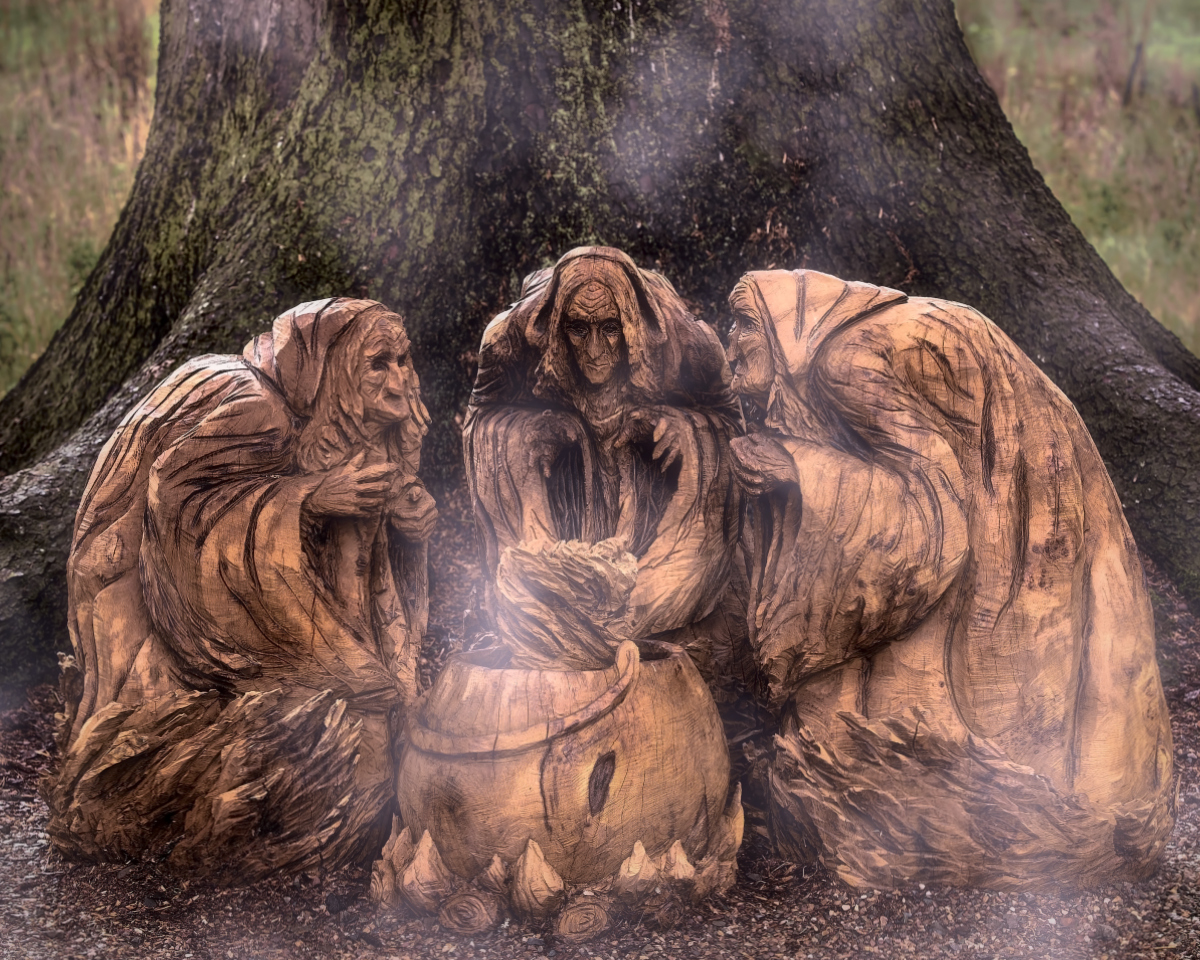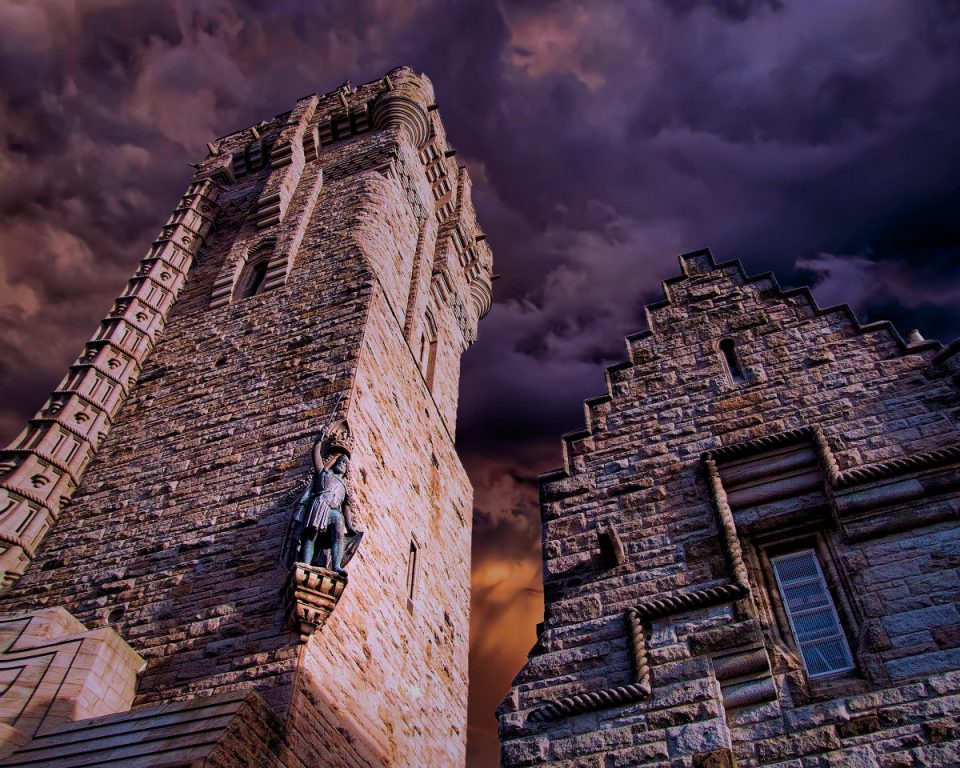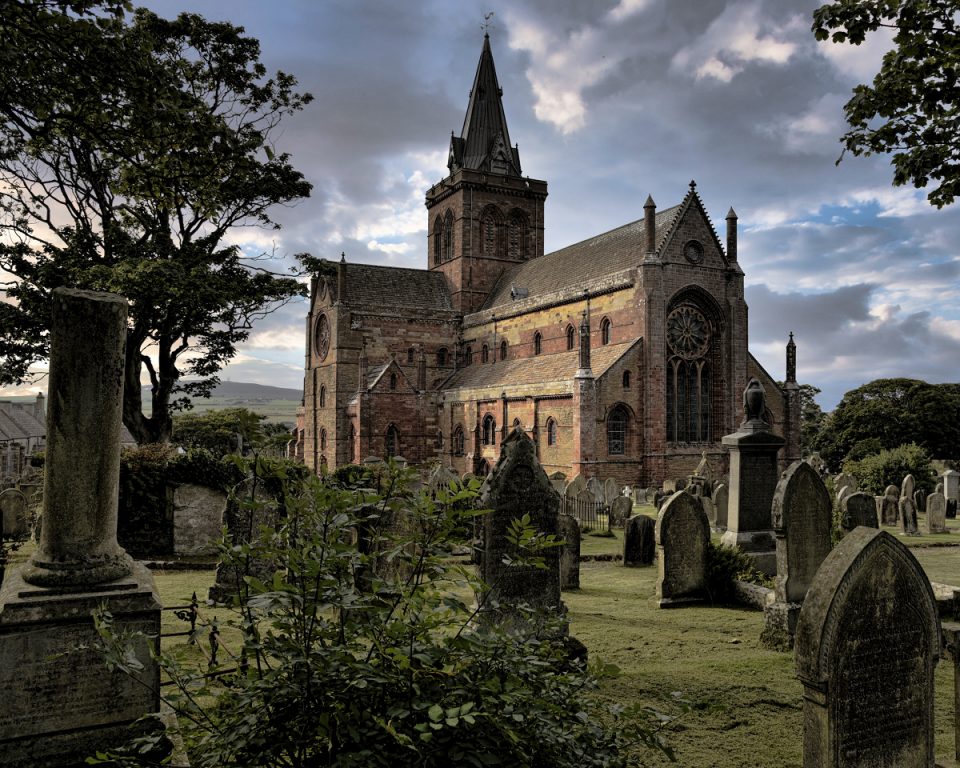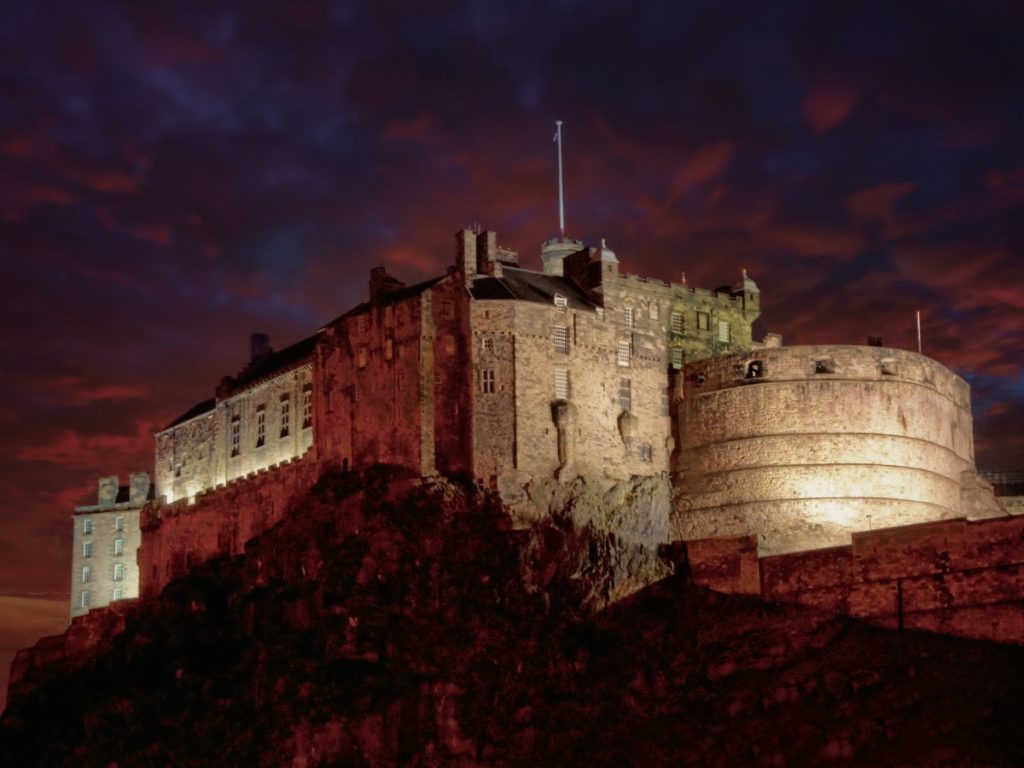MacBeth mac Findlay’s heart pounded as sword clashed against sword. The singing swings of the battle axe splintered both shield and bones. The blood of kin seeped into the sandy shores of Loch Spynie. This was the 15th of August 1040, the twilight years of the Celtic kings of Alba. Then finally, Duncan I, King of Scots received a mortal blow. He was carried from the battleground to the nearby settlement of Elgin, where he succumbed to his wounds. MacBeth was now King.
Duncan’s widow fled with her two sons and took refuge in the courts of the Northumbrian Earl. Meanwhile, Duncan’s son waited in the shadows, nursing his wrath, no doubt fuelled by his Anglo-Saxon benefactors. Young Malcolm Ceann Mor bided his time. The day of vengeance was well-chosen. Seventeen years to the day that MacBeth slew King Duncan at the Battle of Pitgaveny, he was mortally wounded at the Battle of Lumphanan. They say that victors get to re-write history. The Kings that followed MacBeth, claimed their ancestry from Malcolm Ceann Mor and historians are apt to appease the sitting king. Thus, the myths surrounding MacBeth began and culminated in his vilification by one William Shakespeare.
MacBeth the Play
‘MacBeth’ the play is one of William Shakespeare’s most famous works and was written around 1606. It was written to address the political turmoil at the time. King James VI of Scotland had recently ascended to the throne of England. The play was a form of flattery, playing to some of James’ intense beliefs. Shakespeare used the revised second edition of Raphael Holinshed’s Chronicles as the source for most of his historical plays. Alas, Holinshed’s information about MacBeth was inaccurate. Shakespeare went on to embellish this even more.
The play departs dramatically from the truth. According to Shakespeare King Duncan was old but we now know that he was a young king. MacBeth was never Thane of Cawdor and Glamis. Glamis was not even a Thaneage at this point in history. There are no records that Banquo or MacDuff even existed. King Ducan was not stabbed in the back in his bed. According to Shakespeare, MacBeth’s reign lasted for several weeks rather than 17 years. The list goes on.
King James and MacBeth
Of course, Shakespeare had to turn MacBeth into a villain- James was descended from Duncan and Malcolm III. The play is a tale of witchcraft, regicide and the ultimate punishment by death with no legacy.
This was the time of the Scottish Witch Hunts where witches were hunted out and punished for their crimes against the crown and against God. James had direct involvement in several witch trials. It, therefore, comes as no surprise that Shakespeare includes witches in his play and portrays them as having direct ties with demonic beings such as the devil. MacBeth fails to punish the witches, instead using their predictions to carry out a plot of regicide. This decision would ultimately result in MacBeth’s death by the rightful heirs to the throne as well as the loss of eternal honour for himself and his wife. This mirrors the punishment James would have exacted for both witchcraft and regicide.
Why does the play MacBeth focus on Regicide?
James had strong views against regicide. He felt that regicide was a high crime against God because of his belief in the divine right of kings. Immediately prior to the publication of the play, James had been the intended victim of the Gunpowder plot. Harsh judgement was meted out on the conspirators. Guy Fawkes was sentenced to death by drawing and quartering only after intense torture on the rack.
Interestingly, King James did not like the play and forbade further performances. Apparently, he was disgusted by the bloody action. However, without Shakespeare’s play, perhaps MacBeth would have disappeared into the annals of time, unknown to all but a few historians and academics.
But who was the real MacBeth?
The Kingdom of Alba
The events which led to MacBeth’s claim to the throne began with the ascension of Kenneth MacAlpin to the throne. Scotland in the Dark Ages was still a splintered nation of several kingships. The arrival of the Vikings in AD 794, upset the delicate political equilibrium between Scots, Picts, Britons and Angles. Most of the Pictish royalty was wiped out. The Picts and Scots became unified under Cináed mac Alpin (Kenneth, son of Alpin) with Pictland and Dal Riata joining to form Alba. This began the process of Gaelicisation in the former Pictland. Meanwhile, the Scots’ powerbase shifted from the west to the east. MacAlpin’s dynasty was to rule over Alba until the time of MacBeth.
MacAlpin had two sons: Custantin (Constantine) and Áed and in the years that followed, the kingship was to seesaw back and fore between the two branches of MacAlpin’s family, a fate frequently decided by the sword. The succession of a new king became problematic since male relatives competed to inherit the kingdom. At this time, Scotland followed the old ways of inheritance with the crown passing from brother to brother rather than primogeniture where the crown passes from father to son.
Tenth Century Fighting
The tenth century was marked by fratricidal feuding, and civil war broke out between the two branches of the family. On more than one occasion, the men of Moray managed to embroil themselves in the act of King slaying. Malcolm I was killed in a dispute with the men of Moray at Fetteresso and King Dub was killed in the Morayshire town of Forres. The men of Moray always seem to take the side of Áed’s branch of the family. Was it possible that Áed’s descendants were based in Moray?
However, by the time MacBeth was born, Áed’s branch of the family had been annihilated. Around this time, Malcolm II seized the throne by killing his cousin King Kenneth III at the Battle of Monzievard in Strathearn. These were tense times and Malcolm ensured that he had a long reign by removing all the male opposition. He was left with a major succession problem: Malcolm had only fathered daughters. The crown would have to pass to his grandson upon his death.
Moray: The Rebel Province
Moray had once been the power centre of the Pictish Kingdom. The Kings of Fortrui, with their fleet of ships, had once ruled over Pictland from forts such as Burghead. Then the Vikings arrived. Around about this time, Burghead went up in flames. With the Pictish elite removed, a Gaelic aristocracy moved in to fill the power vacuum. There had been for main clans or kindred groupings in the ancient Kingdom of Dal Riata. Kenneth Mac Alpin belonged to Clan Gabrán, descendants of Áedán mac Gabrán, who was ordained king by Saint Columba.
While Kenneth mac Alpin laid claim to the Kingdoms of Dal Riata and Pictland, a rival Dal Riatan family from the more northerly tribe of Loarn was pushing into the Great Glen and establishing itself as the ruler of the Pictish province of Moray. This family claimed their descent from the Dal Riatan King Ferchar Fota. They would become the Mormaers or Earls of Moray.
Frontier Province
Moray was a semi-autonomous region. It was a frontier province, and the Mormaers of Moray held a role of special importance- they were the protectors of the North from Viking incursions. At least one Mormaer of Moray, fell victim to Viking Treachery as told in the story of Maelbrighte the Tooth. But Moray’s Mormaers also had separatist tendencies, a propensity which would frequently put them on a collision course with the crown.
MacBeth’s father, Finnlaech mac Ruadri, Mormaer of Moray was said to be descended from Ferchar Fota by seven generations. It is notable that the Annals of Ulster designate him as ‘ri Alban’ (King of Alba) rather than ‘ri Muiréb’ (King of Moray). Did MacBeth’s father have pretensions to the throne of Alba? With one branch of the House of Alpin destroyed, did the Mormaer of Moray see an opportunity not only to become King of Moray but of all of Alba too?
The Parentage of MacBeth
The records from MacBeth’s time are scant but enough exist to tell us that the real MacBeth was not the despot of Shakespeare’s play. MacBeth was born around AD 1005. His name in his native Gaelic tongue was MacBethad mac Finnlaech. MacBeth means ‘Son of Life’. We do not know who his mother was. Many secondary sources name her as Donada, daughter of Malcolm II King of Scotland. It seems that the proof for this connection is slim.
The only source so far identified which refers to MacBeth´s maternal origin is the Chronicle of Huntingdon which names “Maket Regem [King MacBeth] nepotem dicti Malcolmi”. The word “nepos” could indicate a variety of relationships in addition to grandson. However, it seems that early historians assumed that “grandson” was the correct translation. Thus Holinshed´s Chronicle of Scotland names “Doada” as the second daughter of Malcolm II King of Scotland who married “Sinell the thane of Glammis, by whom she had issue one Makbeth”. Similarly, the Cronykil of Andrew of Wyntoun, records that “Makbeth-Fynlak, his systyr sowne” murdered King Duncan.
If MacBeth’s mother was indeed a daughter of Malcolm II, then MacBeth had as much right to the throne as King Duncan. However, it seems unlikely that he was a descendent of the House of Alpin. Instead, he was following the Moray agenda of becoming King of Alba, on the grounds that a long distant ancestor had once been King of Dal Riata.
The Early Life of MacBeth
The Dynasty of Moray was similar to that of the House of Alpin, in that there were occasional in-house disputes over succession.In 1020, MacBeth’s father was killed most probably by his brother Máel Brigte’s sons, Máel Coluim and Gille Coemgáin. Gille Coemgáin was to become Mormaer of Moray
The Annals of Ulster record that in 1032 “Gille Coemgáin son of Máel Brigte, mormaer of Moray, was burned together with fifty people.”
Although there is no mention of the perpetrator, MacBeth seems to be the most likely candidate. However, Malcolm II also would have had a motive for killing Gille Coemgáin. Gille Coemgáin is believed to have killed Dúngal mac Cináeda, the younger brother of Malcolm II, in 999. However, 33 years is a long time to wait for retaliation. Gille Coemgáin had been married to the Scottish Princess, Gruoch, grandaughter to Kenneth III.
After Gille Coemgáin’s death, MacBeth became the Mormaer of Moray, married the widowed Gruoch and took her son Lulach as his stepson.
A Meeting with Cnut
As early as 1031 MacBeth held some sort of kingship. In the Anglo-Saxon Chronicles he is listed as one of three kings who met with Cnut. The others were Malcolm II and Echmarchach one of the competitors for the Uí Ímair kingdom which included Dublin, Mann and Galloway. No doubt, this was a ploy by Cnut to keep Scotland in as many splintered groups as possible thus ensuring less threat from the north.
Duncan becomes King
In 1034 Malcolm II, the last of the House of Alpin, died. He was followed to the throne by his grandson, Duncan- the same as described by Shakespeare as much revered and gentle and also elderly. In reality, he was a young man promoted well beyond his level of competence. He blundered into several military campaigns including a disastrous attack on Durham in 1039. Duncan was in urgent need of a victory to secure his credibility, so he turned his focus northwards. He would meet the man they called ‘son of life.’
The Battle of Pitgaveny
Except things didn’t go to plan. Duncan faced MacBeth at Balnagowan, Pitgaveny on the outskirts of modern-day Elgin. At this point in time a great sea loch, Loch Spynie stretched almost to Elgin and the battle would have been fought near its shores.
Duncan was fatally wounded and MacBeth jumped at the opportunity, making his way to Scone where he could be inaugurated as King. Duncan’s widow, a native of Northumbria, fled back to her homeland, with her sons, the future kings Máel Coluim III and Domnall III, in tow. So began the reign of MacBeth.
MacBeth the King
As a ruler MacBeth was an effective King. He suppressed a rebellion in Atholl, led by Crínán, Duncan’s father in 1045. After this, MacBeth was evidently unchallenged.
He and his wife were generous benefactors to the church at Saint Andrews with their names appearing in its early charters. They granted land to the Céli Dé Community (a movement of monks in the Celtic Church) of Loch Leven.
In 1050 MacBeth went on a pilgrimage to Rome, where he ‘scattered money like seed’ to the poor. Remarkably, for the time, he returned to find his kingdom still intact with no recorded rebellions during his absence.
In 1052, he became the first Scottish king to welcome Norman Knights into his service. These knights remained loyal to him and in 1054, when a Northumbrian army drove MacBeth out of southern Scotland, all the Normans were killed. MacBeth responded by returning with a larger army and expelled Siward of Northumbria from Scotland.
Praise for Macbeth
Orham states that during MacBeth’s reign, the seasons were productive. The Duan Albanach calls him ‘MacBethad the Renowned’ while the Prophecy of Berchán, a verse history which purports to be a prophecy, describes him as “the generous king of Fortriu”, and says:
‘The red, tall, golden-haired one, he will be pleasant to me among them; Scotland will be brimful west and east during the reign of the furious red one.’
Fatal Injury at the Battle of Lumphanan
In August 1057 Mael Coluim mac Donnahada, better known as Malcolm Canmore or Ceann-mor (“the big chief”) made an attempt at regaining his father’s kingdom but was defeated at Lumphanan in Aberdeenshire. Alas, MacBeth was mortally wounded and died a few days later at Scone.
However, according to a local legend, MacBeth was defeated during the battle and was subsequently decapitated on a stone on a farm called Cairnbeathie (the farm’s name recalling the event).
MacBeth’s body was taken to be buried at Iona. Meanwhile, his stepson Lulach mac Gilla Comgáin succeeded him on the throne.
Malcolm Canmore: The start of a new dynasty
Lulach did not last long as King. The more compassionate chroniclers refer to him as Lulach the Unlucky. Those of a more candid bent refer to him as Lulach the Idiot. He was inaugurated at Scone on the 8th of September 1057 and killed by Malcolm Ceann-mor at Essie in Strathbogie on 17th March 1058. He was later buried on Iona. His son Máel Snechtai became Mormaer of Moray.
Meanwhile, Malcolm Ceann-mor assumed the crown. Along with his second wife Margaret, they established a new dynasty in Scotland, the House of Canmore. They and their descendants were to begin a process of Anglicising Scotland, moving away from the old Celtic traditions and Gaelic language and embracing the concept of feudalism. Alba’s Powerbase moved from Scone with the royal household shifting between Edinburgh and Dunfermline. Moray became increasingly marginalised until it no longer had the political clout to challenge the crown.
Margaret would later become canonised because of her efforts to bring the Celtic church in line with the rest of the Roman Church. The oldest building on the site of Edinburgh Castle is a chapel dedicated to her memory.
The MacBeth Myth Begins
The myth surrounding Macbeth had largely developed by the end of the 14th Century when John of Fordun and Andrew of Wyntoun wrote their histories. Andrew Wyntoun gives the earliest account of the prophecy made to MacBeth. They greet him as ‘Thane of Cromarty’, ‘Thane of Moray’ and ‘King of Scots’ in that order.
Twenty miles east of Inverness on the low-lying strip of land between the Moray Firth and the Cairngorm Mountains lies a crescent-shaped scattering of low-lying glacial mounds. According to local legend, the last mound to the south is where MacBeth met with the three weird sisters who foretold his rise to king and then his future demise. This hill is known as MacBeth’s Hillock. Interestingly, the last mound to the north is known as Downie Hill. This is the place where the ‘Queen of Scottish Witches’, Isobel Gowdie, claimed to have feasted with the king and queen of the fairies.
Witches and fantasy aside, the myths surrounding Macbeth were perpetuated and further embellished by Hector Boece, Walter Bower and George Buchanan.
Later Holinshed’s Chronicles of England, Scotland, and Ireland would borrow its details from Hector Boece’s 1527 Scotorum Historiae which flattered the forebears of Boece’s patron, king James V of Scotland. Holinshed’s works would in turn become the source of historical information for Will Shakespeare’s MacBeth.
The Curse of The Scottish Play
The play is said to be cursed. In fact, so great is the feeling surrounding the alleged curse, that thespians refer to MacBeth as ‘The Scottish Play.
Apparently, at the first performance, the boy who was to play Lady MacBeth fell ill and died immediately before going onto the stage. There was no time to get a replacement and Shakespeare was forced to take the part himself.
During an 1849 performance, a riot broke out amongst the audience leaving thirty dead.
The Curse in Recent Times
In more recent times, some famous actors fell victim to ‘the curse’. In 1937, a weight above the stage mysteriously became untied and crashed within inches of Laurence Olivier. During a 1942 John Gielgud production, three actors were killed and the costume designer killed himself after the first showing. In 1953, Charlton Heston ended up with severe burns to his legs. Inexplicably, his tights had been soaked in kerosene.
And the cause of the curse? Some believe that because the play used real incantations, witches at the initial performance put a curse on all future productions. Alternatively, Will Shakespeare cursed the play himself, after King James had it banned. However, perhaps MacBeth and his wife were so enraged at their character assassinations that they took action from beyond the veil!
The Real MacBeth
It seems the real MacBeth was not the tyrant of Shakespeare’s play. Nor was he the romanticised maligned national hero who had every right to the throne as a uterine descendant of Kenneth, son of Alpin. MacBeth was a good king and under his reign, Alba flourished. Whether or not the play is cursed, Shakespeare has drawn our attention to a man who would otherwise be forgotten in the mists of time.




